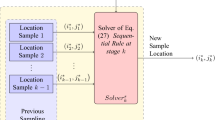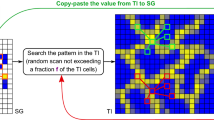Abstract
With increasingly sophisticated acquisition methods, the amount of data available for mapping physical parameters in the geosciences is becoming enormous. If the density of measurements is sufficient, significant non-parametric spatial statistics can be derived from the data. In this context, we propose to use and adapt the Direct Sampling multiple-points simulation method (DS) for the reconstruction of partially informed images. The advantage of the proposed method is that it can accommodate any data disposition and that it can indifferently deal with continuous and categorical variables. The spatial patterns found in the data are mimicked without model inference. Therefore, very few assumptions are required to define the spatial structure of the reconstructed fields, and very limited parameterization is needed to make the proposed approach extremely simple from a user perspective. The different examples shown in this paper give appealing results for the reconstruction of complex 3D geometries from relatively small data sets.
Similar content being viewed by others
References
Arpat B, Caers J (2007) Conditional simulations with patterns. Math Geol 39(2):177–203
Bersezio R, Giudici M, Mele M (2007) Combining sedimentological and geophysical data for high resolution 3-d mapping of fluvial architectural elements in the quaternary Po Plain (Italy). Sediment Geol 202:230–247
Carle SF, Fogg GE (1997) Modeling spatial variability with one and multi-dimensional continuous Markov chains. Math Geol 7(29):891–918
Cornacchiulo D, Bagtzoglou C (2004) Geostatistical reconstruction of gaps in near-surface electrical resistivity data. Vadose Zone J 3:1215–1229
dell’Arciprete D, Felletti F, Bersezio R (2008) Simulation of fine-scale heterogeneity of meandering river aquifer analogues: comparing different approaches, paper presented at geoENV 2008. Southampton, 8–10 September, 2008
Deutsch C, Journel A (1992) GSLIB: geostatistical software library. Oxford University Press, Oxford
Deutsch C, Tran T (2002) FLUVSIM: A program for object-based stochastic modeling of fluvial depositional systems. Comput Geosci 2002(28):525–535
Fiorucci P, La Barbera P, Lanza L, Minciardi R (2001) A geostatistical approach to multisensor rain field reconstruction and downscaling. Hydrol Earth Syst Sci 5(2):201–213
Gómez-Hernández JJ, Wen X-H (1998) To be or not to be multi-Gaussian? A reflection on stochastic hydrogeology. Adv Water Resour 21(1):47–61
Goovaerts P (1997) Geostatistics for natural resources evaluation. Oxford University Press, Oxford
Guadagnini L, Guadagnini A, Tartakovski D (2004) Probabilistic reconstruction of geologic facies. J Hydrol 294:57–67
Guardiano F, Srivastava M (1993) Multivariate geostatistics: beyond bivariate moments. In: Geostatistics-Troia. Kluwer Academic, Amsterdam, pp 133–144
Hurley N, Zhang T (2009) Method to generate fullbore images using borehole images and multi-point statistics. In: SPE middle east oil and gas show and conference, 15–18 March 2009, Bahrain, Bahrain
Journel A, Isaaks E (1984) Conditional indicator simulation: application to a Saskatchewan deposit. Math Geol 16(7):685–718
Journel A, Zhang T (2006) The necessity of a multiple-point prior model. Math Geol 38(5):591–610
Kerrou J, Renard P, Hendricks-Franssen H-J, Lunati I (2008) Issues in characterizing heterogeneity and connectivity in non-multi-Gaussian media. Adv Water Resour 31(1):147–159
Khoshbakht F, Memarian H, Mohammadnia M (2009) Comparison of Asmari, Pabdeh and Gurpi formation’s fractures, derived from image log. J Petroleum Sci Eng 67(1–2):65–74
Kitanidis P (1986) Parameter uncertainty in estimation of spatial functions: Bayesian analysis. Water Resour Res 22(4):499–507
Kostic B, Aigner T (2007) Sedimentary architecture and 3-D ground penetrating radar analysis of gravelly meandering river deposits (Neckar valley, SW Germany). Sedimentology 54:789–808
Kumar D, Ahmed S (2008) Reconstruction of water level time series in an aquifer using geostatistical technique. In: Groundwater dynamics in hard rock aquifers. Springer, Berlin, pp 191–200
Lantuéjoul C (2002) Geostatistical simulation. Models and algorithms. Springer, Berlin
Lefranc M, Beaudoin B, Chiles J-P, Guillemot D, Ravenne C, Trouiller A (2008) Geostatistical characterization of Callovo–Oxfordian clay variability from high-resolution log data. Phys Chem Earth, Parts A/B/C 33(Supplement 1):S2–S13
Marache A, Riss J, Gentier S, Chiles J-P (2002) Characterization and reconstruction of a rock fracture surface by geostatistics. Int J Numer Anal Methods Geomech 26(9):873–896
Mariethoz G (2009) Geological stochastic imaging for aquifer characterization. University of Neuchâtel, Neuchâtel, Switzerland
Mariethoz G, Renard P, Cornaton F, Jaquet O (2009a) Truncated pluri-Gaussian simulations to characterize aquifer heterogeneity. Ground Water 47(1):13–24
Mariethoz G, Renard P, Froidevaux R (2009b) Integrating collocated auxiliary parameters in geostatistical simulations using joint probability distributions and probability aggregation. Water Resour Res 45:W08421
Mariethoz G (2010, in press) A general parallelization strategy for random path based geostatistical simulation methods. Comput Geosci
Mariethoz G, Renard P, Straubhaar J (2010, submitted) The direct sampling method to perform multiple-points simulations. Water Resour Res
Miall A (1996) The geology of fluvial deposits. Springer, New York
Mosley P (1982) Analysis of the effect of changing discharge on channel morphology and instream uses in a Braided river, Ohau river, New Zealand. Water Resour Res 18(4):800–812
Nichols G (1999) Sedimentology and stratigraphy. Blackwell, London
Okabe H, Blunt M (2004) Multiple-point statistics to generate pore space images. In: Geostatistics Banff. Springer, Berlin, pp 763–768
Ortiz JM, Deutsch CV (2004) Indicator simulation accounting for multiple-point statistics. Math Geol 36(5):545–565
Remy N, Boucher A, Wu J (2009) Applied geostatistics with SGeMS: A user’s guide. Cambridge University Press, Cambridge
Renard P, Gómez-Hernández J, Ezzedine S (2005) Characterization of porous and fractured media. In: Encyclopedia of hydrological sciences. Wiley, New York
Rubin Y, Lunt I, Bridge J (2006) Spatial variability in river sediments and its link with river channel geometry. Water Resour Res 42:W06D16
Saripally I (2008) Evaluating data conditioning accuracy of MPS algorithms and the impact on flow modeling. In: 21th SCRF Meeting, Stanford University, May 8–9, 2008
Shannon CE (1948) A mathematical theory of communication. Bell Syst Techn J 27:379–423
Straubhaar J, Walgenwitz A, Renard P, Froidevaux R (2008) Optimization issues in 3D multipoint statistics simulation, paper presented. Geostats 2008, 1–5 Dec 2008, Santiago, Chile
Strebelle S (2002) Conditional simulation of complex geological structures using multiple point statistics. Math Geol 34(1):1–22
Strebelle S, Payrazyan KJC (2002) Modeling of a deepwater turbidite reservoir conditional to seismic data using multiple-point geostatistics. In: The 2002 SPE annual technical conference and exhibition. San Antonio, September 29–October 2, SPE paper 77425
Wu H, Pollard D (2002) Imaging 3-D fracture networks around boreholes. AAPG Bull 86(4):593–604
Wu J, Boucher A, Zhang T (2008) A SGeMS code for pattern simulation of continuous and categorical variables: FILTERSIM. Comput Geosci 34(12):1863–1876
Youngseuk K, Mukerji T, Amos N (2004) Permeability prediction from thin sections: 3D reconstruction and Lattice–Boltzmann flow simulation. Geophys Res Lett 31:(L04606)
Zappa G, Bersezio R, Felletti F, Giudici M (2005) Modeling heterogeneity of gravel-sand, braided stream, alluvial aquifers at the facies scale. J Hydrol 325(1–4):134–153
Zhang T, Switzer P, Journel A (2006) Filter-based classification of training image patterns for spatial simulation. Math Geol 38(1):63–80
Author information
Authors and Affiliations
Corresponding author
Rights and permissions
About this article
Cite this article
Mariethoz, G., Renard, P. Reconstruction of Incomplete Data Sets or Images Using Direct Sampling. Math Geosci 42, 245–268 (2010). https://doi.org/10.1007/s11004-010-9270-0
Received:
Accepted:
Published:
Issue Date:
DOI: https://doi.org/10.1007/s11004-010-9270-0




